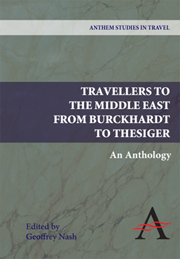Book contents
- Frontmatter
- Contents
- Acknowledgements
- Introduction
- PART ONE THE COMING OF EMPIRE 1800–1879
- The Ottoman Empire and Egypt
- 1 The Spirit of the East
- 2 Eothen
- 3 The Crescent and the Cross
- 4 Eastern Life, Present and Past
- 5 Visits to Monasteries of the Levant
- 6 Letters from Egypt
- Arabia
- Persia
- PART TWO COLONIALISM AND RESISTANCE 1880–1950
- Bibliography
5 - Visits to Monasteries of the Levant
from The Ottoman Empire and Egypt
Published online by Cambridge University Press: 05 March 2012
- Frontmatter
- Contents
- Acknowledgements
- Introduction
- PART ONE THE COMING OF EMPIRE 1800–1879
- The Ottoman Empire and Egypt
- 1 The Spirit of the East
- 2 Eothen
- 3 The Crescent and the Cross
- 4 Eastern Life, Present and Past
- 5 Visits to Monasteries of the Levant
- 6 Letters from Egypt
- Arabia
- Persia
- PART TWO COLONIALISM AND RESISTANCE 1880–1950
- Bibliography
Summary
Son of Viscount Curzon and Baroness de la Zouche and educated at Charterhouse and Christ Church Oxford, Robert had an uneasy relationship with his parents whose long lives precluded him from entering into his inheritance – the family estate at Parham, Sussex – until three years before his own death in 1873. He first travelled in the Levant in 1833–34 after losing his seat as M. P. following the Reform Act of 1832. His troubled relations with his parents partly accounts for his time in the Middle East, which resumed in 1837 with a visit to Egypt, the Natron Lakes in the Libyan Desert, then on to Istanbul, Albania and Greece where he visited the monasteries of Mt. Athos. His time abroad continued with his appointment as Sir Stratford Canning's private secretary at the Istanbul embassy in 1841. The following year he started out for Armenia where he helped resolve border disputes. Together with A.W. Kinglake and Eliot Warburton – with whom he is often compared – Curzon published an account of travel in the Middle East that can be said to have chimed with the early Victorian public mood. As in the work of the other two writers, the voice of Visits to Monasteries in the Levant (1849) might be characterized as confident and proprietary in regard to the land and peoples it describes. What distinguishes Curzon's writing from theirs is a deeper knowledge of the region acquired through longer stays there.
- Type
- Chapter
- Information
- Travellers to the Middle EastAn Anthology, pp. 31 - 36Publisher: Anthem PressPrint publication year: 2009



